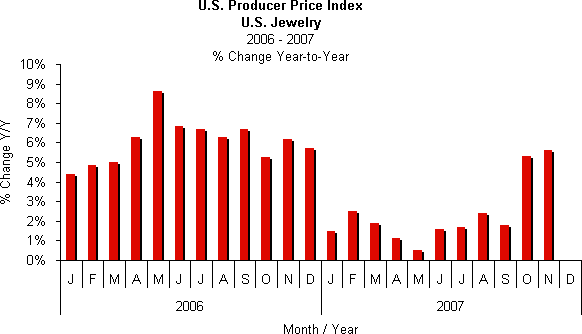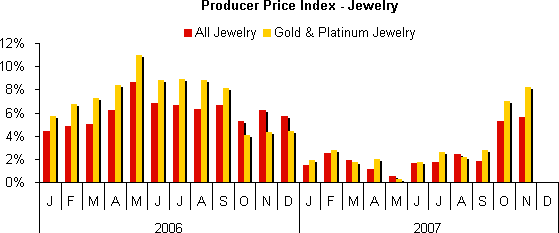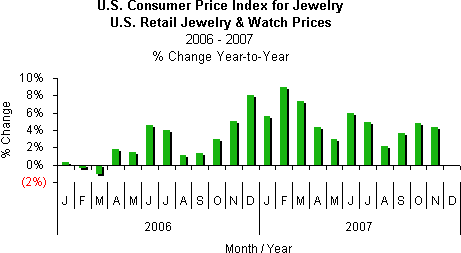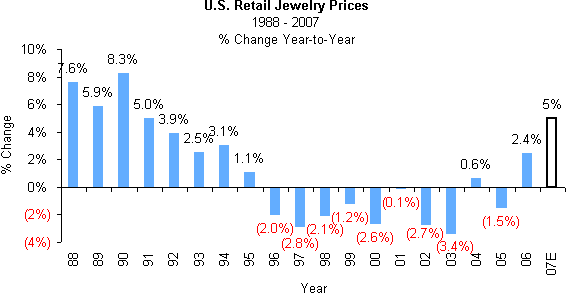IDEX Online Research: Jewelry Prices Higher at Wholesale, But Moderate at Retail in November
January 08, 08
It should come as no surprise to anyone that Jewelry Producer Prices surged to their highest level this year during November 2007. The big surprise, however, is that this price surge did not flow through to retail prices. Instead, the Jewelry Consumer Price Index increase moderated from October’s supercharged pace. There is no question that jewelry suppliers and retailers are unwilling to continue to absorb sharply rising commodity prices. Kay Jewelers has announced that it will reprice its entire line of jewelry after Valentine’s Day 2008. In short, while the inflation numbers on a year-to-date basis for both Jewelry Producer Prices and Jewelry Consumer Prices don’t loom large, recent cost increases have been substantial. Therefore, we look for significant price inflation at all levels of the jewelry distribution pipeline in 2008. It would not surprise us to see jewelry price inflation running at an 8-10 percent level for much of next year, both at the consumer and supplier level. The graph below summarizes the monthly Jewelry Producer Price Index for inflation sine the beginning of 2006. The figures are based on year-to-year comparisons of the While the inflation rate for all jewelry at the producer level was up sharply in November, it was driven primarily by higher precious metal costs. The The graph below compares the inflation rate for “all jewelry” (red bar) versus the inflation rate for “gold and precious metals jewelry” (gold bar). It is clear that inflation of precious metal jewelry is a key component which is pushing up the inflation rate for all jewelry.
Why haven’t retail prices risen along with producer price increases? There are five key reasons:
Jewelry Producer Price Inflation Surges in November

Source: BLS

Source: BLS
Jewelry Retail Price Inflation Continues Higher
Retail prices for jewelry have been on a roller coaster ride all year. Merchants have attempted to cap retail jewelry price inflation, but to no avail. Now that jewelry suppliers have opened the floodgates with sharply higher prices, retail jewelers will have no choice but to raise prices.
Sterling Jewelers, which operates Kay Jewelers, Jared, and a stable of regional brands, has announced that it plans to reprice its entire line of jewelry just after the Valentines selling period in 2008. The company said it had been years since it had repriced many key items, and that margins have deteriorated to the point that it is being forced to revamp its pricing structure. Management would not commit to raising prices to yield historical margin levels; we believe that many online competitors will force jewelers to operate with lower margins while increasing operating efficiencies. Otherwise, the demise of specialty jewelers will accelerate.
The graph below summarizes the percentage change in retail prices of jewelry and watches by month on a year-to-year basis since 2006. The percent change is based on a comparison of the same month a year ago.
 Source: BLS |
Jewelry Price Inflation Will Flare in 2008
While we don’t expect to see significant price inflation in December at the retail level, producer prices will likely continue to rise. As higher costs are pushed down through the distribution pipeline, all participants will be forced to raise their prices. Retail prices will likely hold near current levels during the next couple of months because promotions have been planned and flyers have been printed, all prior to the surge in producer and commodity prices.
Our current forecast calls for about a 5 percent increase in jewelry price inflation at the retail level in 2007, as the graph below illustrates. Frankly, it is about time that retail prices of jewelry rose. In nine of the past twelve years, retail prices of jewelry in the American market declined.
For 2008, we believe jewelry retailers and their suppliers should budget for inflation rates which could reach 8-10 percent for the year.
|
|
